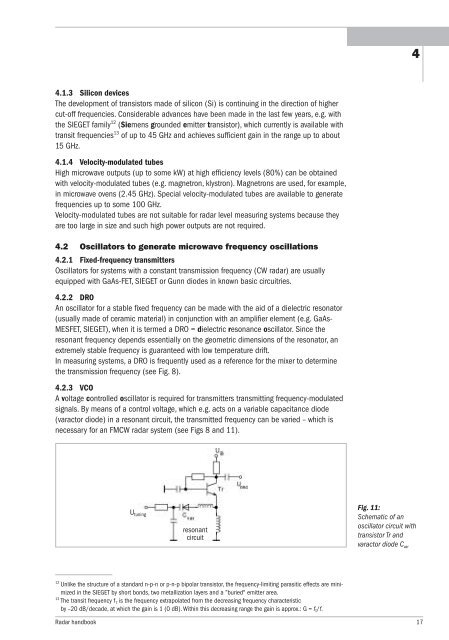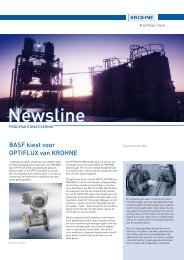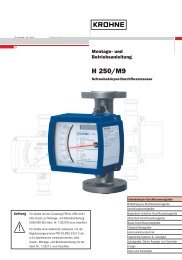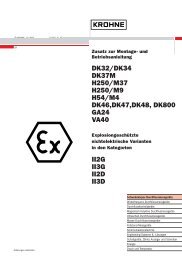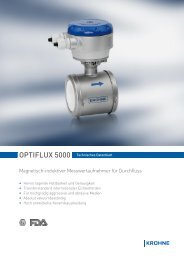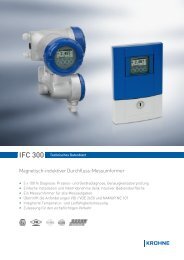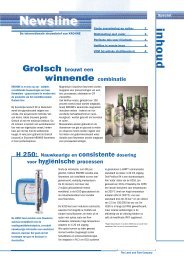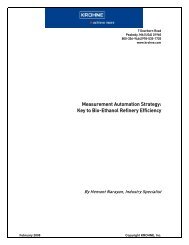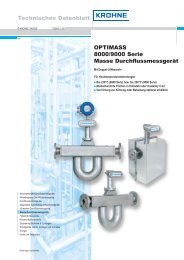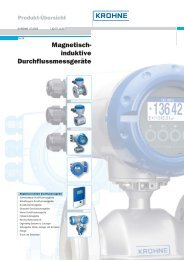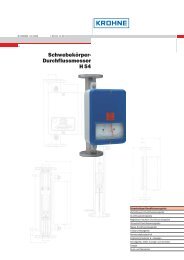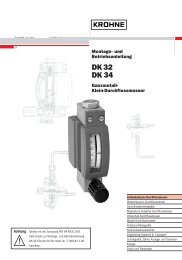Radar Technology for Level Gauging - Krohne
Radar Technology for Level Gauging - Krohne
Radar Technology for Level Gauging - Krohne
You also want an ePaper? Increase the reach of your titles
YUMPU automatically turns print PDFs into web optimized ePapers that Google loves.
4.<br />
4.1.3 Silicon devices<br />
The development of transistors made of silicon (Si) is continuing in the direction of higher<br />
cut-off frequencies. Considerable advances have been made in the last few years, e.g. with<br />
the SIEGET family 12 (Siemens grounded emitter transistor), which currently is available with<br />
transit frequencies 13 of up to 45 GHz and achieves sufficient gain in the range up to about<br />
15 GHz.<br />
4.1.4 Velocity-modulated tubes<br />
High microwave outputs (up to some kW) at high efficiency levels (80%) can be obtained<br />
with velocity-modulated tubes (e.g. magnetron, klystron). Magnetrons are used, <strong>for</strong> example,<br />
in microwave ovens (2.45 GHz). Special velocity-modulated tubes are available to generate<br />
frequencies up to some 100 GHz.<br />
Velocity-modulated tubes are not suitable <strong>for</strong> radar level measuring systems because they<br />
are too large in size and such high power outputs are not required.<br />
4.2 Oscillators to generate microwave frequency oscillations<br />
4.2.1 Fixed-frequency transmitters<br />
Oscillators <strong>for</strong> systems with a constant transmission frequency (CW radar) are usually<br />
equipped with GaAs-FET, SIEGET or Gunn diodes in known basic circuitries.<br />
4.2.2 DRO<br />
An oscillator <strong>for</strong> a stable fixed frequency can be made with the aid of a dielectric resonator<br />
(usually made of ceramic material) in conjunction with an amplifier element (e.g. GaAs-<br />
MESFET, SIEGET), when it is termed a DRO = dielectric resonance oscillator. Since the<br />
resonant frequency depends essentially on the geometric dimensions of the resonator, an<br />
extremely stable frequency is guaranteed with low temperature drift.<br />
In measuring systems, a DRO is frequently used as a reference <strong>for</strong> the mixer to determine<br />
the transmission frequency (see Fig. 8).<br />
4.2.3 VCO<br />
A voltage controlled oscillator is required <strong>for</strong> transmitters transmitting frequency-modulated<br />
signals. By means of a control voltage, which e.g. acts on a variable capacitance diode<br />
(varactor diode) in a resonant circuit, the transmitted frequency can be varied – which is<br />
necessary <strong>for</strong> an FMCW radar system (see Figs 8 and 11).<br />
U tuning<br />
resonant<br />
circuit<br />
12 Unlike the structure of a standard n-p-n or p-n-p bipolar transistor, the frequency-limiting parasitic effects are minimized<br />
in the SIEGET by short bonds, two metallization layers and a ”buried" emitter area.<br />
13 The transit frequency f T is the frequency extrapolated from the decreasing frequency characteristic<br />
by –20 dB/decade, at which the gain is 1 (0 dB). Within this decreasing range the gain is approx.: G = f T/f.<br />
<strong>Radar</strong> handbook 17<br />
4<br />
Fig. 11:<br />
Schematic of an<br />
oscillator circuit with<br />
transistor Tr and<br />
varactor diode C var


